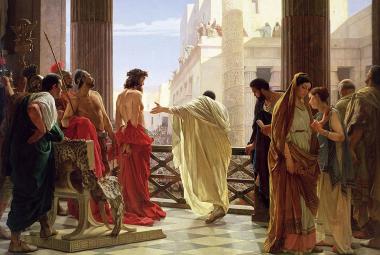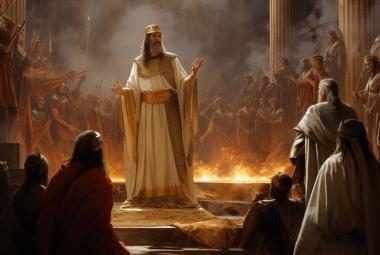In the first part of this essay on putting faith into practice, KI Gold Medallion holder Ray Sarlin examined our foundation in Christ and what it means in practical everyday terms. It’s not enough to simply believe in Him, we must strive to take up our own crosses and follow Him. Part 2 will discuss God’s Word as the source of all Truth and the complete revelation of the true Jesus and His true teaching.
The only reliable source of information about Jesus Christ is found in the Word of God. This primary impetus of the Protestant Reformations[1] of the 16th Century is summed up by the term sola scriptura, which means that the Bible alone is trustworthy. We must test all things by the Bible to discern whether they are of God or man. As Jesus said, “If you abide in My word, you are My disciples indeed.”[2]
Paul reminded the Galatians: “Therefore the law was our tutor to bring us to Christ, that we might be justified by faith. But after faith has come, we are no longer under a tutor.”[3]
Our picture of Jesus is thus incomplete with just the Old Testament. All sixty-six books of the Bible are important. Just as the Old Testament foretold Jesus through prophecy, the Gospels record how Jesus fulfilled the prophecies.
In addition, although each of the Gospels emphasizes different things for different audiences, they share one common trait – all were written to create faith in Jesus Christ as the Son of God, come to earth that we may have life in His name.
The Gospels reveal what the real Jesus actually taught, which is very different from what is taught from most pulpits today. How can we know and follow Jesus without reading and knowing His actual words… without striving to understand His meanings and messages, and without heeding His instructions?
“Not everyone who says to Me, ‘Lord, Lord,’ shall enter the kingdom of heaven, but he who does the will of My Father in heaven. Many will say to Me in that day, ‘Lord, Lord, have we not prophesied in Your name, cast out demons in Your name, and done many wonders in Your name?’ And then I will declare to them, ‘I never knew you; depart from Me, you who practice lawlessness!’”[4]
Contrary to the “cheap grace” and Sunday attendance that many people think is all that’s needed to follow Jesus, the Gospels inform us what Jesus actually said, “Then He said to them all, ‘If anyone desires to come after Me, let him deny himself, and take up his cross daily, and follow Me. For whoever desires to save his life will lose it, but whoever loses his life for My sake will save it. For what profit is it to a man if he gains the whole world, and is himself destroyed or lost?’”[5]
Yet many today see following Jesus as a type of smorgasbord, “I’ll take the love stuff but leave out all of the hellfire and brimstone.” Following the Way is not a multiple choice quiz, it is following the Way of Life as opposed to the Way of Death! Jesus charged His followers to “…observe ALL things whatsoever I have commanded you.”[6]
But the Bible doesn’t end with the four Gospels. Jesus told the Apostles that more needed to be said, saying: “I have yet many things to say unto you, but ye cannot bear them now. Howbeit when he, the Spirit of truth, is come, he will guide you into all truth: for he shall not speak of himself; but whatsoever he shall hear, that shall he speak: and he will shew you things to come. He shall glorify me: for he shall receive of mine, and shall shew it unto you.”[7]
Due to the apostles’ inability to receive all the truth at that time, Jesus left it up to the Holy Spirit to complete the work of guiding them into all the truth. Therefore, to truly find His Will for us today, we must find His Way in the book of Acts and the Epistles and the rarely preached on book of Revelation.
Only ten days after Jesus ascended into heaven, “[The disciples] were all filled with the Holy Spirit and began to speak with other tongues, as the Spirit gave them utterance.”[8] The Comforter[9], the Holy Spirit, had arrived. From here on we see the hand of the Holy Spirit guiding the followers of the Way through the next half century or so.
In some cases, we are shown additional words of Jesus that we did not receive through the Gospels; in others, the Holy Spirit guided the words and writings of the apostles and their amanuenses into all truth, as if spoken by Jesus Himself.
“Most assuredly, I say to you, he who receives whomever I send receives Me; and he who receives Me receives Him who sent Me.”[10]
Paul wrote to the Thessalonians, “For this reason we also thank God without ceasing, because when you received the word of God which you heard from us, you welcomed it not as the word of men, but as it is in truth, the word of God, which also effectively works in you who believe.”[11]
If the words of the New Testament are true and complete, and they are, we must assume that the apostles were guided into ALL truth.[12] No further revelation is needed … not church tradition, the Catholic magisterium (teaching authority), papal declarations, the Quran, Shi’a or Sunni or Ibadi hadiths, the Book of Mormon, the Book of Miracles or new religions spawned by personal revelation.
We have in our 66 books by over 40 authors written over nearly 2,000 years everything that we need to live Godly lives! In them we can find the true Jesus and His true teachings completely and fully revealed!
Listen to Peter and Paul.
- “Grace and peace be multiplied to you in the knowledge of God and of Jesus our Lord, as His divine power has given to us all things that pertain to life and godliness, through the knowledge of Him who called us by glory and virtue,”[13]
- “All Scripture is given by inspiration of God, and is profitable for doctrine, for reproof, for correction, for instruction in righteousness, that the man of God may be complete, thoroughly equipped for every good work.”[14]
- “But even if we, or an angel from heaven, preach any other gospel to you than what we have preached to you, let him be accursed. As we have said before, so now I say again, if anyone preaches any other gospel to you than what you have received, let him be accursed.”[15]
Everything that we need is in the Holy Bible! No other revelations are required. As Jude wrote, “Beloved, while I was very diligent to write to you concerning our common salvation, I found it necessary to write to you exhorting you to contend earnestly for the faith which was once for all delivered to the saints.”[16]
Liberal scholarship disputes the traditional authorship, inspiration and dating of many of the New Testament books. Consistent with their negative view of the Bible, they also tend to portray the development of the canon[17] as complex and lengthy (Figure 1). Yet some 5,686 existing Greek manuscripts[18] date to within 100 years of the time of Christ’s crucifixion and resurrection. There are also some 19,000 copies in other contemporary languages including Syriac, Latin, Coptic, and Aramaic.
The evidence shows that all New Testament documents were complete when John completed his final book prior to A.D. 100. Early letters[19] show familiarity with the synoptic Gospels and some of Paul’s Epistles.[20] One such letter was from Ignatian to Polycarp of Smyrna (c.80–155), said to be a fellow disciple of the Apostle John in Ephesus, the wealthy capital of the Roman Province of Asia, where Paul preached during his second missionary journey and ministered for over two years during his third.
What are the requirements for New Testament canonicity? Both Catholic and Protestant traditions recognize four conditions:
- Apostolic Origin — attributed to and based upon the original apostles including Jesus’ half-brothers James and Jude or their amanuenses
- Universal Acceptance — acknowledged by all major Christian communities in the ancient world
- Liturgical Use — read publicly where early Christian communities gathered
- Consistent Message — containing a theological outlook similar to or complementary to other accepted Christian writings.[21]
Alternative Dates for the New Testament Canon
- Prior to A.D. 100 with the completion of John’s writing
- c. 96, Epistle of Clement of Rome to Corinth
- c. 120, Basilides of Alexandria wrote a commentary on the four Gospels
- c. 140 by Marcion of Sinope
- c. 170 in the Muratorian fragment (Canon Muratori)
- c. 180, Irenaeus refers to a four-gospel canon called the Tetramorph
- c. 240, Eusebius in Ecclesiastical History refers to a Canon of Origen
- c. 350 in the Canon of Cyril of Jerusalem (Catechetical Lectures)
- c. 363, confirmed at the Synod of Laodicea
- 367, by Athanasius, Bishop of Alexandria, in his Easter letter “Epistola Festalis”.
- 383 at the Council of Rome noted in the 5th Century Decretum Gelasianum
- 393 at the Synod of Hippo Regis in North Africa
- 394 in the Canon of Amphilochius of Iconium
- 397 at the third Synod of Carthage
- 405 Innocent I’s list of the sacred books
- 692, ratified at the Second Council of Trullan
- 1442 (Feb. 4) at the Council of Florence
- 1546 (April 8), the Council of Trent passed De Canonicis Scripturis
- 1563, the Thirty-Nine Articles of the Church of England
- 1647, the Westminster Confession of Faith (Calvinism)
- 1672, the Synod of Jerusalem (Greek Orthodox)
- 1943 (Sept. 30) when Pope Pius XII decreed the Divino Afflante Spiritu
- 1965 (Nov. 18) when Pope Paul VI decreed Dei Verbum (Vatican II)
Figure 1. Alternative dates for the completion of the New Testament Canon.
Why should the New Testament canon have taken until 1965 or 1546 or even 367 to be established? After all, the text itself gives evidence that apostolic letters were shared among assemblies in different cities.[22]
The Bible also illustrates the closeness of First Century Christians. After persecution in Jerusalem[23], many believers fled abroad preaching the Word.[24] Antioch of Syria became a missionary headquarters.[25] The Council of Jerusalem[26] commissioned Paul and Silas to spread the Good News to the Gentiles. The Way spread from Judea throughout the Roman world during the First Century A.D., carried by the Apostles, evangelists such as Barnabas and Philip and Priscilla and Aquila, the outer group of seventy[27] and many of the thousands who witnessed Pentecost.[28]
Is it possible that God chose the youngest of the Twelve, John, to validate and close the New Testament Canon from his central location in Ephesus before he died? There is, after all, as much evidence of that as there is for the critical theories of modern scholars about the Bible’s authorship and veracity.[29]
The past hundred-plus years has seen an explosion of different Bible translations and versions in English and Spanish. Translating and selling new versions of the Bible has become a lucrative business. Yet the proliferation of Bibles that may differ on key theological points has tended to undermine the principle of sola Scriptura upon which the Protestant Reformations were based. Practically every one of the 150 or so new English versions since 1881 tracks more closely with the Catholic Bible than with the Luther (German), Tyndale, Geneva and King James Versions that revolutionized Christianity nearly 500 years ago.
Does it matter which version we use?
While the answer is beyond the scope of this essay, the version used must matter. Dr. Missler’s 2005 recording entitled How We Got Our Bible in the Koinonia Institute’s BTE501 Hermeneutics course and Ron Matsen’s 2013 DVD entitled Defending the Bible are recommended for further study. There are also many other excellent references available as well.
Dr. Missler is fond of answering questions about which Bible version is best by wryly noting, “The one that you will read.” Despite nearly 2,000 years of continuing attacks against the New Testament’s authority starting with the attacks by the Gnostic in AD 55[30], “We have in our hands, in substantial integrity, the veritable word of God.”[31]
God can speak to us through any version of His Word. Make no mistake, though, while most versions are appropriate for general reading or worship, only a few are suitably accurate for serious study. You are strongly encouraged to do your own research to select a study Bible.
Let us briefly return to the question posed in Part 1: are you a believer in Christ or a follower of Christ?[32] We only find Jesus when we follow Him in true obedience! Jesus noted:
- “If ye continue in my word, then are ye my disciples indeed; And ye shall know the truth, and the truth shall make you free.”[33]
- “If anyone loves Me, he will keep My word; and My Father will love him, and We will come to him and make Our home with him.”[34]
When we keep His Word, Jesus and His Father will abide in us, and we will truly have found the Way!
“Now by this we know that we know Him, if we keep His commandments. He who says, ‘I know Him,’ and does not keep His commandments, is a liar, and the truth is not in him. But whoever keeps His word, truly the love of God is perfected in him. By this we know that we are in Him.”[35]
Before we can keep His Word, we must know and understand it. And we can only know God’s Word through Bible study.
The final part of this article on Putting Faith into Practice will focus on our individual role and duty in an increasingly secular and ungodly culture. What does the Bible say about how we should live in times like these? Taken together, this series is intended to de-mystify modern Christianity for Bible-believing followers of Christ.
Notes:
- Reformation movements included Lutheran, Reformed/Calvinist /Presbyterian, Anglican (Latin for “English”), Radical (e.g., Anabaptist), and Roman Catholic. Rome also spawned the Counter-Reformation under Jesuit command, the effects of which continue today. ↩
- John 8:31 ↩
- Galatians 3:24–25 ↩
- Matthew 7:21–23 ↩
- Luke 9:23–25 ↩
- Matthew 28:20 ↩
- John 16:12–14 ↩
- Acts 2:4 ↩
- Modern Islamic scholarship ironically claims that Muhammad can be found in the New Testament in the Greek word παράκλητος (G3875, paraklētos, comforter) in John 14:16, 15:26, 16:7 and 1 John 2:1, ignoring that John 14:26 clearly identifies the Comforter as the Holy Spirit. ↩
- John 13:20 ↩
- 1 Thessalonians 2:13 ↩
- John 16:13 ↩
- 2 Peter 1:2–3 ↩
- 2 Timothy 3:16–17 ↩
- Galatians 1:8–9 ↩
- Jude 1:3 ↩
- A “Biblical Canon” is a complete and authoritative collection of books. ↩
- Norman Geisler & Peter Bocchino, Unshakeable Foundations, (Minneapolis, MN: Bethany House Publishers, 2001) p. 256. ↩
- For example, the seven epistles of Ignatius of Antioch (c.35–c.107) ↩
- For example, 1 Corinthians, Ephesians, Romans ↩
- Just, Felix, S.J. “New Testament Canon.” Catholic Resources for Bible, Liturgy, Art, and Theology. Loyola Institute for Spirituality, 2 Feb. 2012. Web. 09 Feb. 2015. ↩
- Revelation 2–3; Colossians 4:16 ↩
- Acts 8:1 ↩
- Acts 8:4 ↩
- Acts 8:11 ↩
- Acts 8:15 ↩
- Luke 10:1 ↩
- Acts 2:5 ↩
- All evidence in both cases is circumstantial at best, but the Canonical Theory of John is at least logical and has not been disproved by inconvenient facts arising from modern era archaeological finds. ↩
- 2 Peter 2:1–3 ↩
- Kenyon, Frederic G. as quoted by Chuck Missler in Supplementary Notes: How We Got Our Bible, Koinonia House, 2005, 30. ↩
- Sarlin, Ray. Putting Faith into Practice – Our Foundation in Christ. Personal UPDATE 25.2 (February 2015): 49–54. Print. ↩
- John 8:31–32 ↩
- John 14:23 ↩
- 1 John 2:3–5 ↩






